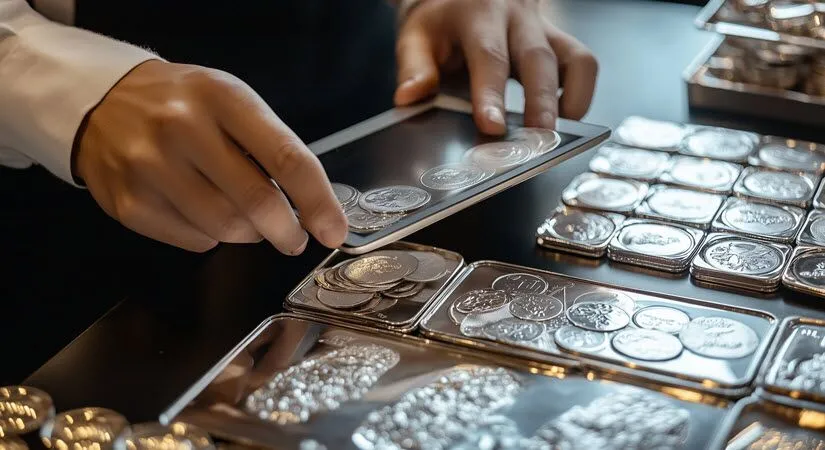Retail investors are organizing online once again to create a “short squeeze” of silver. The last time this happened, back in 2021, silver price shot up 18% in just THREE DAYS. March 31 is the target date – and that’s right around the corner…
According to precious metals industry news outlet Kitco, retail investors are once again planning an imminent silver squeeze.
The last time this happened, way back in 2021 (remember GameStop?), the price of silver shot from $25 to $29.50 in just three days – while related assets (miners and so on) rose some 30-40% over the same period.
More details in the interview below.
What is a short squeeze?
First, let me explain what “shorting” is.
Investors who believe an asset’s price will decline can short sell the asset. Essentially, they:
- Borrow an asset from a broker
- Sell the borrowed assets on the open market at its current price
- Wait for the price to drop
- Buy back the loaned asset at a lower price
- Return the borrowed asset
- Pocket the difference in price
Shorting is an aggressive trading strategy that’s notoriously popular among hedge funds. Short selling can be done on margin, meaning speculators borrow the original asset on credit. As you can imagine, a great deal of short-selling can suppress prices, flooding the market with borrowed assets for sale which pushes its price down.
Massive short-selling of any asset can create tremendous downward pressure on price, creating a self-reinforcing feedback loop that keeps the asset’s price low. That’s exactly what Peter Krauth says is happening with silver in the interview above.
“If you look at the ratio of paper silver to physical silver, we’re seeing something like 378 to 1 – well beyond any other futures market for metals.”
Short selling is quite risky – because there is no limit to how high an asset’s price can rise, meaning potential losses are theoretically unlimited.
The goal of the original #silversqueeze campaign (and the latest iteration) is to create a dynamic where short sellers are forced to liquidate their positions, buying up assets to liquidate their short position.
Here’s how this works:
- Brokers who lend assets to short sellers on credit carefully watch price changes
- When brokers see a heavily shorted asset’s price rise, they take risk management steps
- A margin call occurs when brokers realize they’ve extended too much credit
- In this situation, brokers demand additional collateral to balance their increased risk
- If speculators can’t deliver additional collateral, brokers liquidate their trades automatically
- …and suddenly, supply dynamics reverse – instead of many borrowed shares for sale pushing price down, a spike in demand for the asset drives the price up
- A rapidly rising price creates more margin calls…
Essentially, a short squeeze reverses the price suppression dynamic of massive short-selling. It creates a positive feedback loop which sends the asset’s price surging.
The Reddit WSB silver short squeeze was driven by the belief that silver was undervalued and that its price had been artificially suppressed by large financial institutions massively shorting silver. By banding together to buy silver, everyday Americans aimed to expose market manipulation and level the playing field against the big financial institutions who were profiting from price suppression.
It worked – temporarily, at least. Silver price rose 18% in just three days. So what’s different this time?
The gold-to-silver ratio is historically skewed against silver. This indicates that silver is rather undervalued relative to gold.
There’s a real tightness in silver supply. As Krauth points out, London Bullion Market silver stockpiles are down 40-50% since 2021.
Tariffs could play a major role – 80% of our nation’s silver supply is imported. And our two primary sources of silver are Canada and Mexico. After “Liberation Day,” April 2, the vast majority of new silver imports may cost 25% more.
Industrial demand has risen from 50% to 60% – silver’s use in photovoltaics, electronics and electric vehicles is simply irreplaceable. So there’s more demand than before.
Elevated lease rates (when owners of silver lend it out to investors or manufacturers) are a clear indication of tighter supplies of physical silver.
How will this silver squeeze play out?
Frankly, it’s impossible to know. The last silver squeeze, while very dramatic, didn’t last very long. It really did result in a tighter market, though – our own suppliers (and most retailers) simply ran out of many silver bullion products.
Whether or not March 31 results in a short-term or long-term increase in silver’s price, the supply and demand dynamics have shifted.
Personally, I believe that silver offers a much more compelling case for investors right now – while gold has already hit 17 record high prices this year. Silver, on the other hand, although it has slightly outperformed gold over the last 12 months, still has a lot of room to rise before approaching new record prices.
If you haven’t already diversified your savings with physical silver, I encourage you to learn more about its compelling supply and demand dynamic. (And if you’re already a Birch Gold customer, you can buy silver today and diversify your savings with physical silver bullion right now – just call us at (877) 749-7738.
Do so right away, though. Regardless of how the March 31 silver squeeze plays out, there’s truly a shortage of physical silver developing…
Read the full article here



